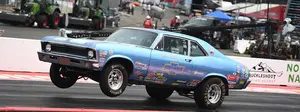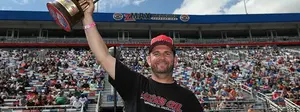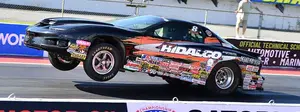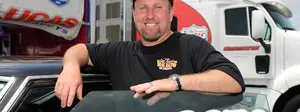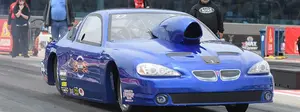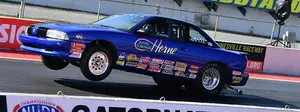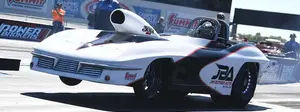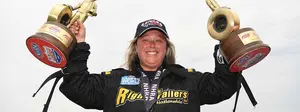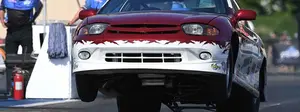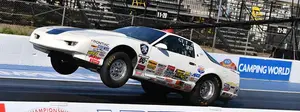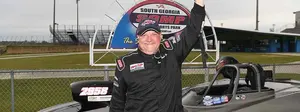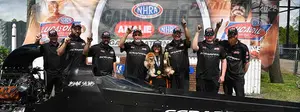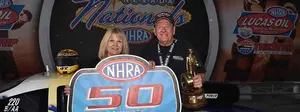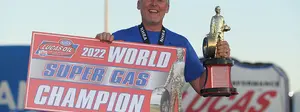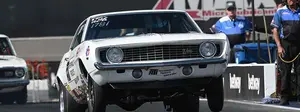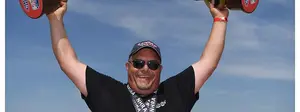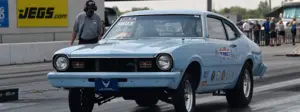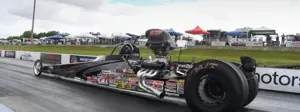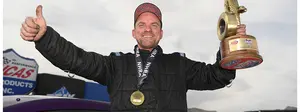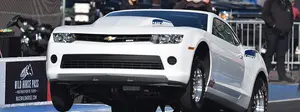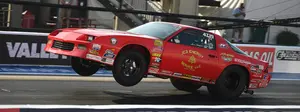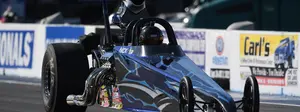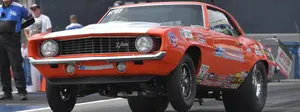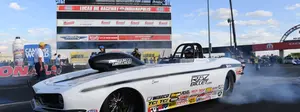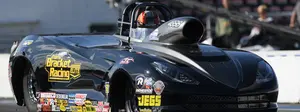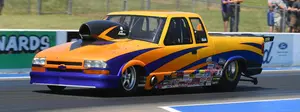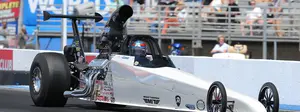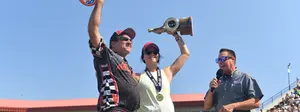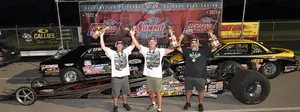

The Sports Report: One man’s quest for an NHRA national record
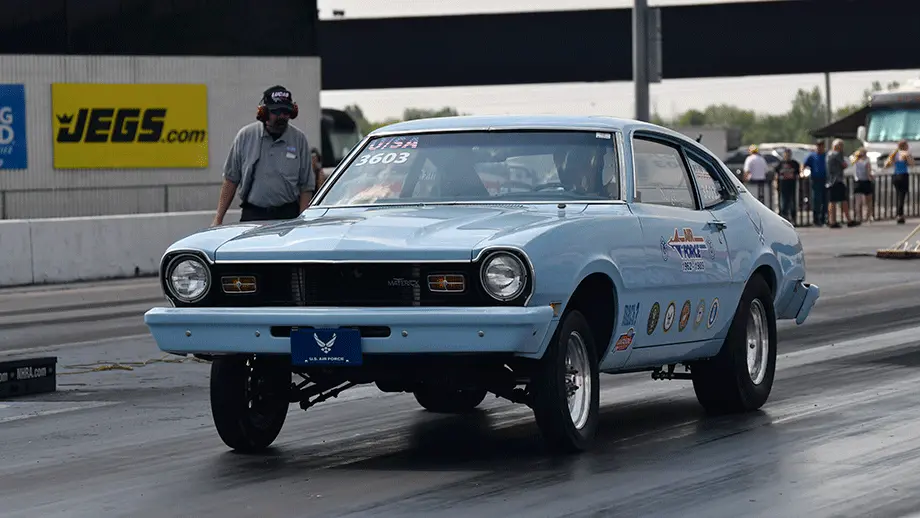
Some stories seem to write themselves and this is certainly one of them. Following last month’s Division 3 Lucas Oil series opener in Indy, longtime class racer and U.S. Air Force veteran Fred “Sarge” Elsass wrote to chronicle his quest to set a record with his U/SA ’74 Maverick. The following is Fred’s first-person account of the event:
This is a tale about what it took to set an NHRA Stock Eliminator class record. The record was for a ’74 Ford Maverick with a factory horsepower rating of 141 and a shipping weight of 2,709 pounds, which competes in U/Stock Automatic. NHRA rates the engine at 151 horsepower with a minimum weight of 3,190 pounds. My crew chief and I assembled the engine, and we believe that the car is legal in all aspects. By the way, my crew chief is my bride, Jill.
We made plans to set the national record at the first NHRA Division 3 race at Lucas Oil Indianapolis Raceway Park the weekend of May 20-22. We arrived at the track, on Thursday and pitted next to Rusty Hall, his wife, Kelly and daughter, Shelby. Rusty is a two-time U.S. Nationals winner and a Ford specialist. The Hall’s drive Fox body Ford Mustangs with five-speed manual transmissions. Shelby is a Jr. Dragster champion.
It stormed the night before we arrived, and grass parking did not look good for us. Another racer attempted to pit next to Rusty and buried his truck and trailer in the soaked ground. I decided to unload the car on a hard surface and was going to pit in front of Rusty. Since I have a lightweight aluminum open trailer I thought that I would be fine but I was wrong. We eventually got out of the mud and back to our hotel.
With more rain in the forecast, Division 3 Director William Tharpe made the decision to adjust the schedule. Rather than test and tune on Friday and record run on Saturday I was told to report to lane 8 and wait.
Prior to this I drove the in the pits to warm the engine and drive train and found the engine had a misfire. Something was not right. Rusty and I checked the spark plug wiring and could not find anything out of order so I went to the lanes. I had placed a large “R” on the rear window so tower personnel knew I was attempting to set a record. I made the run, and the car had a miss all the way to the finish line. I was lucky to run 14.215 which was quicker than the current record of 14.35. The car weighted 3,115, five pounds more than required. I also reported to fuel check and provided a cup of fuel which passed. The engine was also sealed prior to the second run, which is required.
Since I had previously run a 13.85 at another track last year, I knew something was seriously wrong. As any educated trouble-shooter would do Rusty and I decided to start with the basics. We quickly discovered the engine timing was at 55 degrees of advance so the engine was misfiring due to severe detonation. I understand how it could have happened because I have a harmonic dampener on the engine and the timing marks are really hard to see. It was no one’s fault because I have been around racing since 1973 and if I had a dollar for every time I messed up I would be wealthy. It is not right to expect perfection from others when you are not perfect. Once the timing was adjusted, I drove the car around in the pits and it was perfect.
Prior to my second run I added 10 pounds and made sure that the fuel cell was full to the top. Once again Stock Eliminator was called to the lanes. At 4:20 p.m. I made my second pass and knew immediately that we had found the problem. The car ran 13.978. I went from No. 42 out of 82 cars to number 10 on the qualifying sheet. I arrived at the scales and once again I was shocked. The car weighed 3,190. Had it weighed one pound less we would have lost the record. I passed fuel check and the technical crew instructed me to drive into a stall in the Teardown Barn at the end of the track.
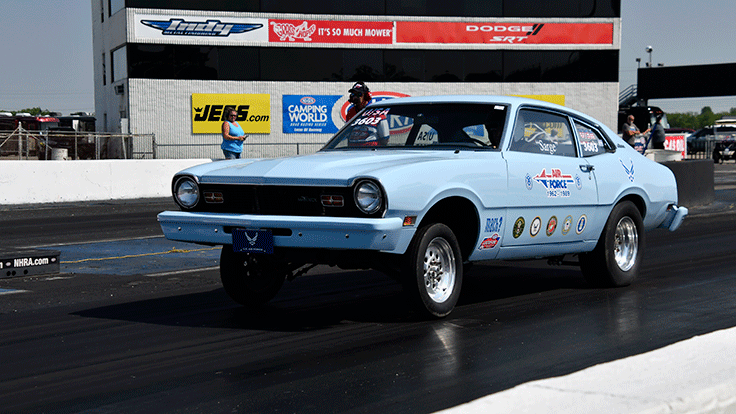
Rusty arrived in his golf cart and we went to get my truck to get the tools we needed to take the engine apart. For those who might not know, Stock Eliminator is a difficult category to certify records since there are strict rules. The first time I tried to set a record, Red Anderson, one of the best tech inspectors and a real gentleman there ever was, disqualified me for a camshaft with .003-inch too much lift on the intake lobe. That’s about the thickness of a human hair. That’s not enough to affect performance, but those are the rules.
Jill and I, along with the Hall family, began the certification process at around 5:30. We drained the radiator, removed the carburetor, the intake manifold, and one cylinder head. These items were checked to make sure that they had the correct factory casting numbers used for that specific engine. The carburetor venturi and throttle bores were measured and were found to be within factory limits. The intake manifold was visually checked to assure it had not been modified. The engine block was also checked to assure that the bore, stroke, deck height, and gasket thickness were within allowable limits. The pistons were NHRA approved, the camshaft intake and exhaust lobes were measured for allowable lift on the head that was not removed.
The cylinder head was inspected to assure that all runners’ intake and exhaust had not been modified in any way. Next, a combustion chamber was measured with a burette graduated in CC’s which contained alcohol with green dye in it to assure that the volume of the chamber was more than the minimum specified by the factory. Rusty removed pair of valves from one chamber and the intake and exhaust diameter was measured to assure they were not larger than factory specifications.
This is where we almost lost it. I was not aware that all cylinder head runners were to have an allowable volume in both the intake and exhaust. There had been no specifications set for the legal heads on my engine. The tech inspectors called NHRA headquarters in California and it took 30 minutes for a final decision to be made. The decision was that since my heads had runners that were legal they would be measured with all heads with a casting number of Ford D20E-BA. The wheelbase was also measured and found to be within the allowable tolerance.
At that point we were deemed to be legal and the new record was ours at 14.215 seconds and 92.76 mph. Now, we had to put the engine back together. We started the process at about 5 p.m., refired the engine at 11 p.m., and got back to our motel just before midnight. We were asleep at 1:30 a.m. and back at the track by 7 a.m. Jill and I looked at our best run the day before, checked the weather, and selected 13.93 as our dial-in.
I was paired against a AA/SA Corvette with a 10.15 dial-in. I was not concerned about reaction time because I had a .001 on my second pass the day before. I guess I should have been concerned. When I got my time slip I ran a 13.935 on a 13.93. That is .005-second from perfect. The car did not let me down, but I sure left it down. I tried to make up for my lack of sleep by taking a nap on the starting line. My reaction time was .196. There are a thousand ways to lose but only one way to win and I have been on both ends. Losing stung, but we left with a national record, which is not too bad.
There are many people who made this possible including my sponsors, Sarchione Ford, H&H Quick Machine, Minute Man Press was well as the Hall family, Steve McBride, Eric Petit (Race Mod) and my lovely bride, Jill. I also must thank all the wonderful and professional people from NHRA Division 3 who put together a great race in spite of miserable weather.























